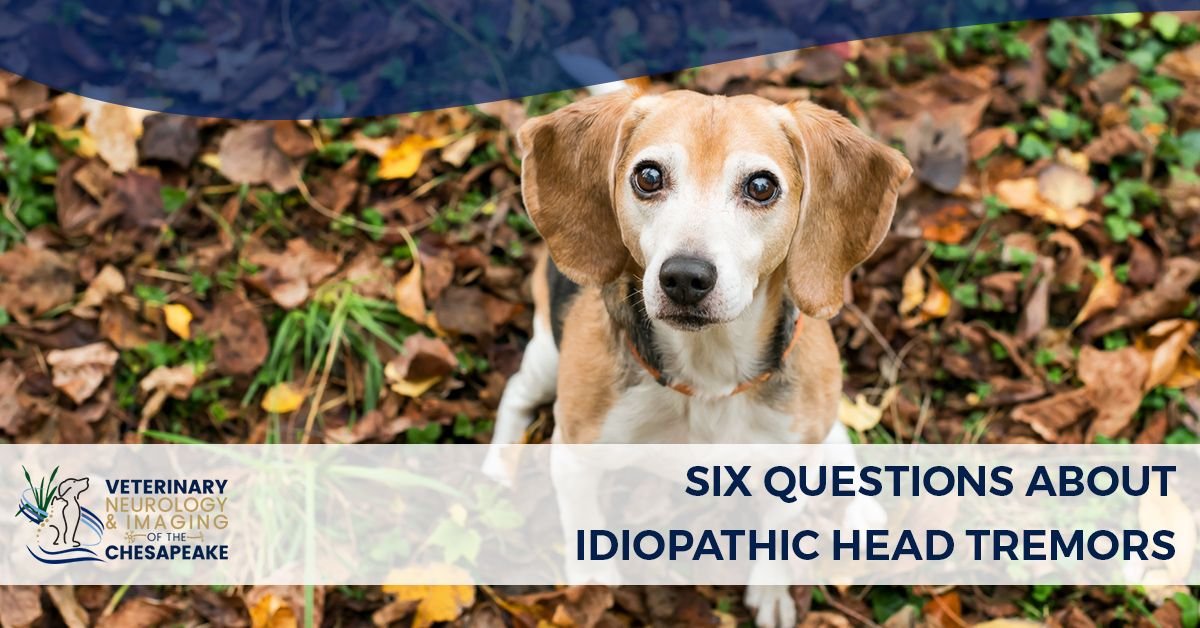SIX QUESTIONS ABOUT IDIOPATHIC HEAD TREMORS
Laura Landstra and Jay McDonnell, DVM, MS, Diplomate ACVIM (Neurology)
1. What are idiopathic head tremors?
Idiopathic head tremors are a series of repetitive, horizontally (“no” gesture) or vertically-directed (“yes”), involuntary muscle contractions involving the head and neck. A typical episode lasts about three minutes (yet may seem to last much longer as you are watching it!).
Dogs remain fully conscious and aware during the episode, and when the episode ends, your dog should be completely unaffected. The tremors are benign – meaning the dog is not caused any pain or distress, and there are no short or long-term effects.
2. Who gets them?
Young to middle-aged male and female dogs are most commonly affected. All dogs including mixed breed dogs have been seen with these tremors but Dobermans, Bulldogs, French Bulldogs, Boxers, and Labradors seem to be more commonly affected.
3. What causes them?
We don’t know, hence the term “idiopathic.” The exact cause of head tremors has yet to be determined. However, the most likely cause is dyskinesia (a movement disorder) that originates in the basal ganglia – the area of the brain involved in patterned motor activity. Another theory is that affected dogs have an abnormality involving the stretch mechanism and the proprioceptive pathway of the head – i.e., the trigeminal nerve. This theory suggests that when the dog’s attention is diverted during an episode, the head tremors temporarily stop because the neck muscles contract, thereby releasing the stretch mechanism that first provoked the tremors. In both instances, there is likely a genetic basis since it occurs most commonly in certain breeds of dogs.
4. How are they diagnosed?
Idiopathic head tremors are a diagnosis of exclusion, meaning that other diseases must be investigated and ruled out before idiopathic head tremors can be diagnosed. A diagnostic workup may include a bile acid test (pre- and post-prandial), ocular examination, brain MRI, and a cerebrospinal fluid (CSF) analysis. These tests will allow your veterinarian to ensure that your dog’s behavior is not caused by an ocular or progressive central nervous system problem before he/she makes a diagnosis of idiopathic head tremors. Dogs with idiopathic head tremors do not exhibit any other neurological abnormalities, and will have normal findings from both the MRI and CSF analysis.
5. What should I do when my dog is having an “episode?”
Don’t panic! Your dog is not affected by the tremors, but may become alarmed or stressed by your reaction. Distracting your dog is the most helpful way to end the episode. Try supporting your dog’s head, or offer your dog a treat such as peanut butter, Karo syrup, honey, or vanilla ice cream in an attempt to distract your dog out of the episode. If there is someone available, have them videotape the episode. If the episode does not spontaneously terminate in 5-10 minutes, try to distract them with food or walking outside.
6. What about treatment?
Currently, there is no treatment for idiopathic head tremors. Head tremors often are confused with epileptic seizures; in these cases the patient is prescribed phenobarbital. However, this drug does not improve idiopathic head tremors, and long-term administration may have deleterious effects on the liver. The most helpful “treatment” for idiopathic head tremors is to distract the patient out of the episode, as described above.
Press play to view the video of Yukon, an Old English Bulldog that presented with episodes of “head bobbing.” He is rapidly shaking his head in a “yes” motion. It started all of a sudden and would occur for about 4 or 5 minutes at a time. He had 4 previous episodes the day this video was taken. Head bobbing is also referred to as idiopathic head tremors. The head bobbing started all of a sudden and would persist even while responding to the owner.

